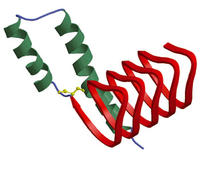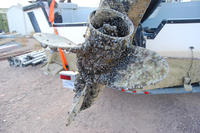-
Cell phone-based sensor detects E. coli
Researchers have developed a new cell phone-based fluorescent imaging and sensing platform that can detect the presence of the bacterium Escherichia coli in food and water
-
-
New app to help fight nonnative species invasion of U.S.
Nonnative species invading the United States — animals, pathogens, and plants — deplete water supplies, poison wildlife and livestock, and damage property in urban and rural areas at a cost of about $138 billion annually; the U.S. Forest Service funded the development of an iPhone application that helps people identify harmful, non-native plants
-
-
Middle school robotics team develops solution to food poisoning

A group of eight middle school students in California has developed an electrolyzed water vending machine that can cheaply and effectively reduce food contamination
-
-
U.S. extends zero tolerance policy to six additional E.Coli serogroups
The U.S. Department of Agriculture has taken additional steps to fight E. coli in the food supply; the new policy adds six E. coli serogroups to the list of sergroups which are not allowed to be present in raw ground beef or the meat used to make raw ground beef; the beef industry says it will be too expensive to implement, and U.S. trading partners said preventing their beef from entering the U.S. unless tested for the six serogroups would violate existing trade agreement
-
-
Using ozone to kill prions dead

Prions are among the worst infectious-disease agents; these proteins are resistant to a wide variety of extreme disinfectant procedures; they have been identified as the culprits behind mad cow disease and chronic wasting disease in animals and humans, and are also implicated in Creutzfeldt-Jakob disease and other prion-related disorders
-
-
Food safety business plan competition
Two Michigan-based organizations announce a business plan competition for ventures in the food safety area; entrepreneurs with new food safety business concepts will compete for $10,000 prize
-
-
Discovery paves way for salmonella vaccine
More than 1.4 million cases of salmonella occur annually in the United States, at an estimated cost of $3 billion and the loss of 580 lives; around the world, this increasingly antibiotic-resistant food-borne bacteria that kills hundreds of thousands of people worldwide each year; , immunologists have taken an important step toward an effective vaccine against salmonella
-
-
Electron beam reduces virus-related health risk in lettuce, spinach
Current health-care costs in the United States associated with foodborne viruses are estimated at about $6 billion; scientists show that electron-beam irradiation can reduce the health risks in iceberg lettuce and spinach, but note that electron-beams are not meant to be used as a “stand-alone” or “clean-up” technology
-
-
Cold plasma reduces harmful bacteria on raw chicken
Recent high-profile outbreaks of foodborne illness have involved contaminated fresh produce, but the most common source of harmful bacteria in food is uncooked poultry and other meat products; studies have shown that plasma could successfully reduce pathogens on the surface of fruits and vegetables without cooking them, and scientists demonstrates that plasma can be an effective method for killing pathogens on uncooked poultry
-
-
Research collaboration to fight Campylobacter jejuni
Campylobacter, primarily C. jejuni, is the third leading cause of death from foodborne infections in the world; in the United States alone, it affects nearly 2.4 million people, causes an estimated 58,000 illnesses and 200 deaths, and costs companies millions of dollars in recall losses each year
-
-
Invaders wreak havoc on U.S. ecosystems

In the decade since the 9/11 attacks, DHS’ focus on combatting terrorism has left some of its core agencies ill-equipped to perform its other missions, namely the Customs and Border Protection’s (CBP) ability to prevent invasive plants and insects from entering the United States and wreaking havoc on crops
-
-
Europe crops damaged by pollution crossing oceans, continents
Pollution originating from North America is responsible for a 1.2 million ton annual loss of wheat in Europe; this is the biggest intercontinental ozone pollution-related impact on any food crop
-
-
New food-pathogen detection system
A new food pathogen detection system is based on a combination of technologies involving isothermal DNA amplification and bioluminescence detection
-
-
Farmers urge Congress to reject antibiotic restrictions in animals
Pending bills H.R. 965 (House) and S. 1211 (Senate) would remove specific antibiotics and classes of antibiotics from animal feed; the purpose is to make sure that bacteria these antibiotics are aimed to combat do not become drug-resistant, thus endangering human health and lives; farmers and ranchers say the bills go too far
-
-
New $25 million beef safety research effort
The $25 million effort will focus on ways to reduce the occurrence and public health risks from Shiga toxin-producing Escherichia coli (STEC), a serious threat to the food supply that results in more than 265,000 infections in the United States each year
-
- All
- Regional
- Water
- Biometrics
- Borders/Immig
- Business
- Cybersecurity
- Detection
- Disasters
- Government
- Infrastructure
- International
- Public health
- Public Safety
- Communication interoperabillity
- Emergency services
- Emergency medical services
- Fire
- First response
- IEDs
- Law Enforcement
- Law Enforcement Technology
- Military technology
- Nonlethal weapons
- Nuclear weapons
- Personal protection equipment
- Police
- Notification /alert systems
- Situational awareness
- Weapons systems
- Sci-Tech
- Sector Reports
- Surveillance
- Transportation
Advertising & Marketing: advertise@newswirepubs.com
Editorial: editor@newswirepubs.com
General: info@newswirepubs.com
2010-2011 © News Wire Publications, LLC News Wire Publications, LLC
220 Old Country Road | Suite 200 | Mineola | New York | 11501
Permissions and Policies
Editorial: editor@newswirepubs.com
General: info@newswirepubs.com
2010-2011 © News Wire Publications, LLC News Wire Publications, LLC
220 Old Country Road | Suite 200 | Mineola | New York | 11501
Permissions and Policies
